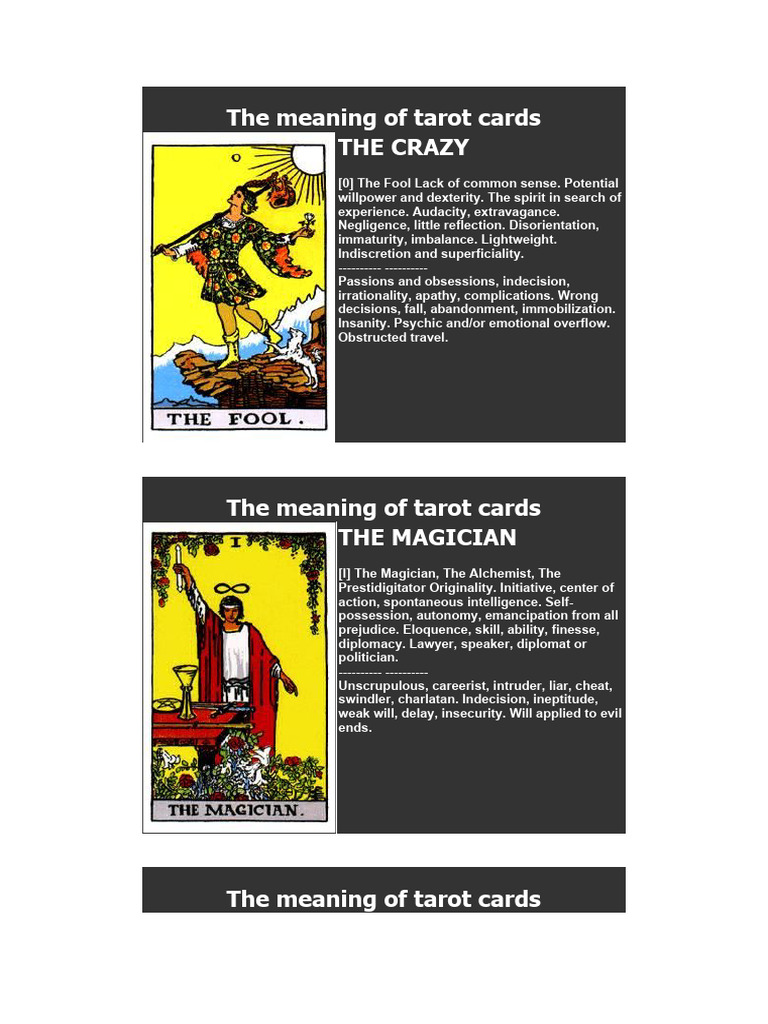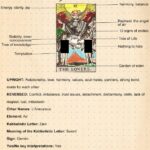The enigmatic world of tarot cards has captivated countless individuals for centuries. This intricate system of divination, steeped in symbolism and archetypes, serves as a powerful conduit for introspection and self-awareness. However, the allure of tarot transcends mere fortune-telling; it invites contemplation on the human experience, prompting introspections that provoke profound revelations. Understanding the meanings encapsulated within tarot cards unveils rich layers of significance that resonate deeply with those who seek insight.
At its core, the tarot is composed of 78 cards, which can be divided into two primary categories: the Major Arcana and the Minor Arcana. The Major Arcana consists of 22 cards, each representing significant life lessons, spiritual themes, and pivotal moments in human experience. These cards are akin to the chapters of one’s life narrative, showcasing the journey from innocence through various trials to ultimate enlightenment. The Minor Arcana, on the other hand, comprises 56 cards, delineated into four suits: Cups, Pentacles, Swords, and Wands. Each suit embodies different aspects of life, such as emotions, material wealth, intellect, and creativity.
Each tarot card is imbued with a rich tapestry of meanings, interwoven with symbolism that evokes a range of interpretations. For instance, the Fool, often depicted as a carefree wanderer, symbolizes new beginnings, spontaneity, and the willingness to take risks. This card invites the querent to embrace their adventurous spirit, reminding them of the beauty of uncharted paths. Conversely, the Tower, which illustrates a crumbling edifice, typically signifies upheaval, chaos, and the necessity of transformation. The tumultuous nature of this card serves as a reminder that sometimes, destruction is integral to rebuilding and growth.
Furthermore, the significance of each card can shift dramatically depending on the context of the reading and the surrounding cards. A card that may convey positive attributes in one instance could embody challenges in another—that fluidity is part of tarot’s profound intrigue. The interplay between cards fosters an intricate narrative that encourages deep consideration of one’s circumstances, challenges, and aspirations, paving the way for targeted reflection.
Moreover, the tarot’s rich symbolism offers a veritable feast for the imagination. The imagery on the cards is laden with archetypal motifs that tap into the collective unconscious. The recurring figures, colors, and symbols serve as a mirror reflecting our psychological states, revealing hidden desires, fears, and strengths. For instance, the image of the Empress, exuding femininity and abundance, may invoke feelings of nurturing and fertility, while simultaneously provoking discussions on gender roles and personal empowerment. Each card acts as a gateway to exploration, encouraging users to delve deeper into their own psyche.
The tactile experience of handling tarot cards also plays a significant role in its allure. The physical act of shuffling and drawing cards fosters a profound connection to the experience. Many find solace in the ritualistic nature of a tarot reading, a practice that creates a space conducive to contemplation and personal growth. This ritual can be an invitation to pause amidst the chaos of daily life, allowing individuals to engage in reflective practices that can illuminate their path.
The resonance of tarot can also be attributed to its ability to articulate the inexpressible. Life often presents a cacophony of emotions and experiences that challenge articulation. Tarot serves as a language of its own, speaking to the unsaid and the deeply felt. A single card can encapsulate complex emotions, prompting a dialogue that allows individuals to confront their inner turmoil. Many find relief in expressing their struggles through the lens of tarot, as if the cards elucidate the intricacies of their journey.
This fascination is also often underpinned by an innate desire for meaning in an unpredictable world. In an era characterized by uncertainty and rapid change, many individuals turn to tarot as a source of guidance and reassurance. The cards symbolize a quest for clarity amidst confusion, bridging the gap between the known and the unknown. In many ways, it serves as a comforting artifact, offering a semblance of control over life’s unpredictability. Through the guidance of the cards, individuals endeavor to glean insights that may align their actions with their innermost intentions.
Furthermore, the tarot exists as a historical tapestry, woven through various cultures and epochs. From its origins in the 15th century to its revival in the 20th century as a spiritual tool, tarot reflects societal shifts and evolving perspectives on spirituality and self-exploration. This historical dimension enriches the practice, offering a continuity that few other divinatory systems can claim. Each card not only embodies personal meaning but also carries whispers of the past, providing a multi-dimensional approach to understanding the human condition.
In conclusion, the meaning of tarot cards is not merely a compilation of definitions and interpretations but rather a multifaceted exploration of human experience. The depth of symbolism, the nuanced interplay between cards, and the global cultural contexts anchor its intrigue. The journey through tarot serves not only as a tool for divination but as a profound reflection on one’s life narrative, enhancing self-awareness and fostering growth. Passionate seekers of wisdom often find in the delicate artistry of tarot a profound resonance, leading to insights that echo far beyond the cards themselves.







Leave a Comment